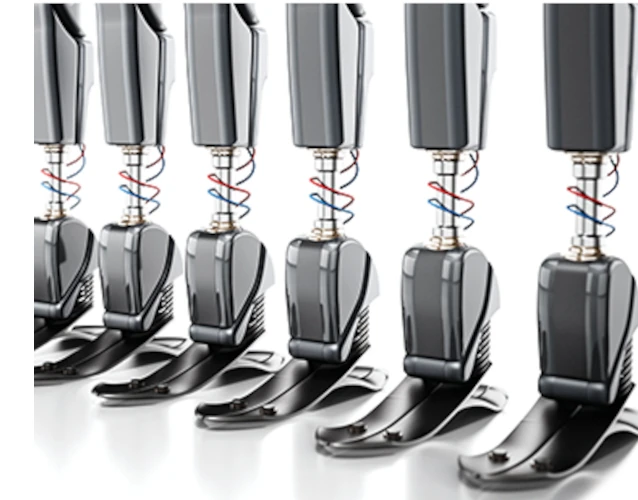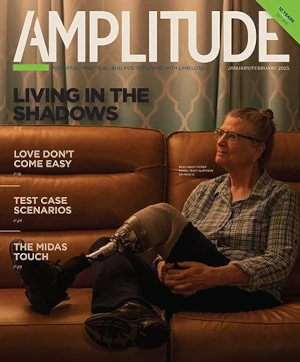
Powered-knee and powered-ankle prosthetic legs have given lower-limb amputees a big boost, vastly increasing users’ comfort and confidence on stairs, hills, rocky trails, and other challenging terrain. But for all their improvements in function, these devices still lack efficiency in variable topography. Transitions among gaits—from flat ground to stairs, from a gentle incline to a steep hill, and so forth—doesn’t happen smoothly or intuitively. Ergo, it requires a front-end learning curve and an ongoing cognitive load to use these devices.
Researchers at Northwestern University and Shirley Ryan AbilityLab are attempting to conquer that summit. In the fall edition of Wearable Technologies, they describe a powered prosthetic leg that lets amputees shift gaits easily and intuitively as the ground rises and falls. “This training-free and intuitive control method works across different ambulation modes,” they write, a big step toward unlocking the full potential of this class of devices.
The secret sauce is a gait-control mechanism that employs a deep neural network, or DNN. If you’re not exactly sure what a DNN is (we weren’t), here’s a pretty good introduction. Basically, it’s an advanced form of artificial intelligence that synthesizes multiple types of input, analyzes complex data sets, predicts outcomes, and learns from its own mistakes. Virtual assistants such as Siri run on DNNs. Netflix and other streaming networks use DNNs to learn about your viewing habits and suggest new content you might like. They’re employed in autonomous vehicles, facial recognition software, digital marketing, and a range of other commonplace applications.
Many current powered prosthetic legs are controlled by AI, but these systems employ a hierarchical structure that requires multiple handoffs to transmit the AI’s commands to the components that do the actual work. High-level controllers send signals to one or more mid-level controllers, which in turn transmit instructions to low-level controllers that drive the powered joints. “We believe that an alternative approach to solving this problem would be to use deep-learning tools to create a direct mapping between the sensors available on the device and the motor commands required to restore locomotion,” write this paper’s authors. “DNNs enable end-to-end learning from inputs to outputs with little or no prior knowledge, and this simplifies the system.”
The researchers tested the device on half a dozen above-knee amputees. To set a baseline, all subjects first completed a series of ambulation tests on varying surfaces (flat, inclined, and stairs), with a fob being used to manually change settings among different ambulation modes. Next, they executed the same walking tasks using the DNN-equipped device. To assess the neural networks’ learning capacity, the subjects performed five separate trials for each gait mode. “Though the model was only trained from a relatively small number of subjects, who walked a combined total of 5,417 steps, the method showed promising results, even when tested by a novel subject,” the authors explained. “The DNN . . . allowed the subjects to ambulate successfully in most trials, with an overall success rate of 96%.”
The subjects’ qualitative experiences of the DNN-equipped leg were highly inconclusive. “Users reported that they felt differences between the two methods,” the paper notes, “but most noted that it was difficult to say which method, if either, was preferred. Detailed comparisons that consider variable factors, such as metabolic costs, may be needed to verify which is better.”
Finally, the authors noted that the DNN’s performance in this preliminary trial might have been constrained by the narrowness of the training foundation. “Including data from more users,” they noted, “as well as users performing a wider variety of postures to initiate movement, including a greater variability within each ambulation mode, may allow the model to recognize a higher percentage of tasks.”
The entire paper is open-source. It’s extremely dense and technical, but if you’re mechanically inclined or just curious about the hurdles engineers face in building the prosthetic future, you can read it at Wearable Technologies.




